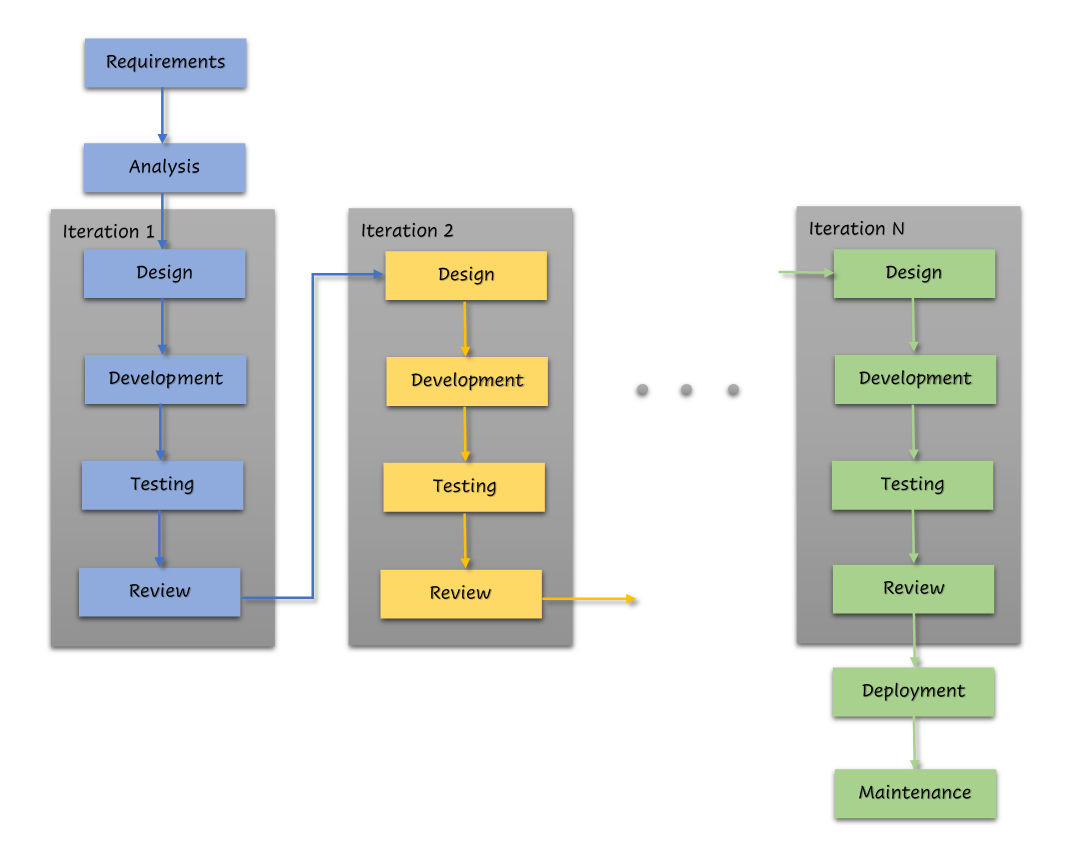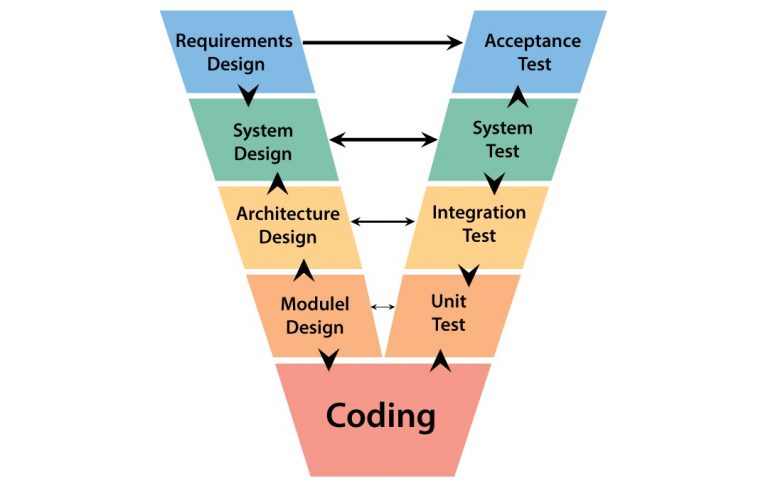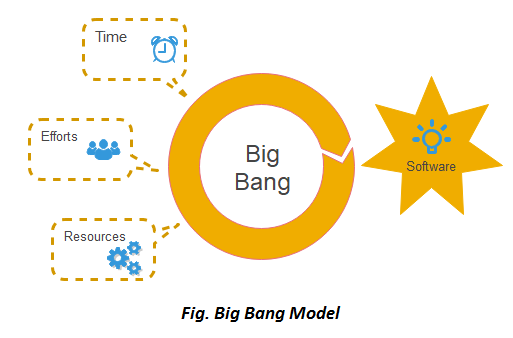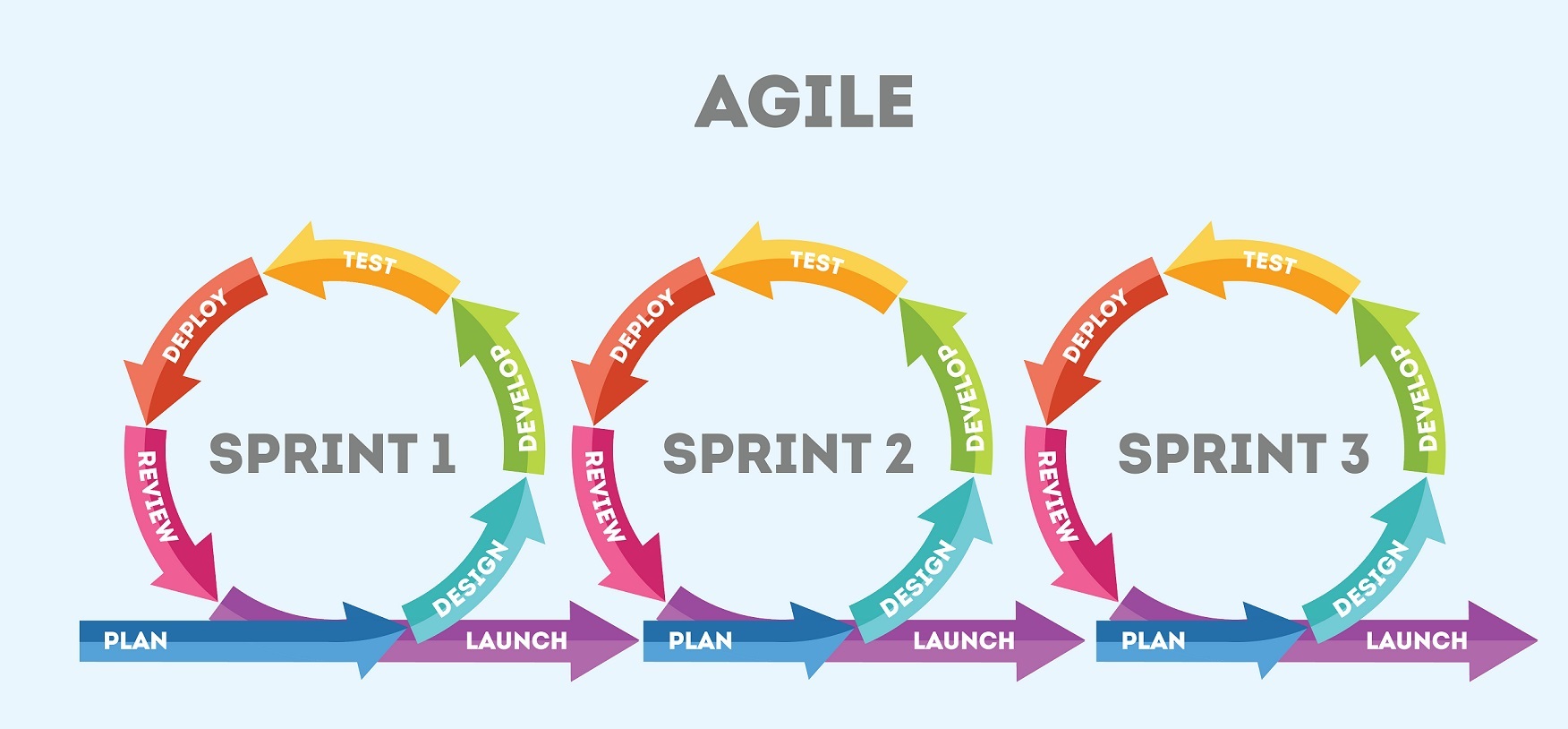
Open-Source Internship opportunity by OpenGenus for programmers. Apply now.
In this article, we have presented the Interview Questions on Software Development Life Cycle models with detailed answers.
1. What is Software Development Life Cycle?
Software Development Life Cycle or SDLC is a framework that outlines the tasks that must be completed during the software development process. SDLC is a well defined procedure followed for a software project, within an organization. It comprises of a thorough plan elucidating the details on how to create, maintain, replace, and modify or improve particular software.
Many alternative software development approaches could be used during the development process. SDLC is helpful for raising software quality and making sure it accurately matches user expectations and requirement.
2. What are the advantages of SDLC?
SDLC outlines a methodology for the entire development process of a software which results in a high-quality product which meets the user requirements. The following are the advantages of SDLC:
-
Definite Goal: It clarifies what the issue or objective is. When tackling a big project, it is simple to get ahead of yourself. With the SDLC, one can identify the objectives and issues clearly, allowing for the precise and pertinent implementation of the plan.
-
Controlled development: The project is organised and well-designed. Until the previous stage is finished and approved by the project manager, project participants cannot advance to the subsequent step. At the completion of each step, a formal review is conducted, giving the project manager the most supervision.
-
Proper testing: Before being implemented, the project is properly tested. When a project is carried out through an SDLC, the product is continuously checked and tested at every stage to ensure performance and functionality. There are multiple tests involved like white box test, black box test, unit test, integrated test, etc.
-
Well documentation: The loss of a project member without the SDLC can set you back and potentially damage the project. The SDLC provides you with an organised and well-documented paper trail of the whole project, complete with records of everything that happens. So, if a key project member leaves, a replacement member can continue where the previous one left off.
-
Meeting constraints: A well-organised plan helps the developers to stick to the budget and time constrains while maintaining the quality of the product. A plan can be formulated according to the agreed upon deadline and expenses. Members of the project can submit their work to an integrated system that flags any work that is past due. When the project manager spends less time micromanaging, they have more time to focus on enhancing efficiency and productivity.
-
Iterative: The project can be repeated indefinitely until it is perfect. Because the stages are designed to feed back into the earlier stages, the SDLC model gives the project flexibility. The project is improved and updated continuously using the feedback mechanism until it meet the requirements.
-
Seamless process: A software development life cycle is the solution when creating and implementing a project. It is the most effective technique to ensure optimal control, minimise difficulties, and allow the project manager to operate production without micromanaging the developers.
3. Describe the stages of SDLC.
SDLC has various stages to ensure a systematic and well-defined development process.

-
Planning and Requirement Analysis: The most critical and necessary stage in SDLC is requirement analysis. It is carried out by senior members of the team with input from all stakeholders and domain experts or SMEs in the industry. Details such as end users, objective and goal of the product, user requirements, etc. are specified at this stage. This data is then used to determine the main project approach and conduct product feasibility studies in economic, operational, and technical aspects.
-
Defining Requirements: Defining requirements is a step in the planning process that determines what the application is supposed to accomplish and what it requires. The development team analyses the requirements while keeping the design and code of the software in mind. This is handled through the use of an SRS (Software Requirement Specification) document, which includes all of the product requirements to be defined and developed throughout the project life cycle.
-
Designing: This phase includes extracting all requirements, analysis, and design information from the software project. The SRS serves as a reference for product architects in designing the optimum architecture for the product under development. Typically, many design approaches for the product architecture are presented and documented in a DDS - Design Document Specification. This DDS is reviewed by all essential stakeholders, and the optimal design strategy for the product is chosen based on many characteristics such as risk assessment, product robustness, design modularity, budget, and time restrictions. It is a model of how a software application will operate. This phase's specifics include architecture, platform, security, and user interface.
-
Implementation and Development: The actual development of the product begins at this stage of the SDLC. During this stage, the programming code is generated in accordance with the DDS. Code generation can be conducted without much difficulty if the design is detailed and organised. Developers must adhere to their organization's coding rules, and programming tools such as compilers, interpreters, debuggers, and so on are used to generate code.
-
Testing: During this phase, product flaws are discovered, tracked, corrected, and retested until the product satisfies the quality requirements specified in the SRS. Following the generation of the code, it is compared to the requirements to ensure that the solutions are satisfying the demands identified and acquired during the requirements stage. System testing, unit testing, integration testing, and acceptance testing are carried out. It's crucial to test an application before making it accessible to users.
-
Deployment: The product is ready for deployment and is made available to clients once it has undergone extensive testing and satisfies the requirements. The scale of the project affects how complicated the deployment will be. Many businesses favour automating the deployment procedure.
-
Maintenance: During this time, the developed product is monitored for any required modifications. In order to keep up with the evolving user end environment or technology, the product is updated frequently. If users uncover bugs that weren't found during testing, it becomes necessary to address these problems, which can require new development cycles.
4. What are the disadvantages of SDLC?
-
Increased time and cost: SDLC processes occur one after the other. This requires more time and cost as each stage needs to be properly concluded before progressing further. If the planning is not done properly, the project will take longer and cost more.
-
Details specification in advance: The details of the product has to be specified in the beginning. This leaves low scope of improvement as problems arise during the later stage of development.
-
Low flexibility: SDLC provides low flexibility due to the inability to retract or go back a stage. It is difficult to alter or change the product due to a lack of flexibility.
-
Heavy documentation: SDLC requires a lot of paperwork and documentation in order to monitor progress. This takes a lot of time that hinders progress.
5. What are SDLC models? Name important SDLC models.
There are several predefined and constructed software development life cycle frameworks that are used in the software development process. These patterns or designs are known as Software Development Process Models. To ensure success in the software development process, each process model follows a different set of specific procedures.
The most important and popular SDLC models followed are−
- Waterfall Model
- Iterative Model
- Spiral Model
- V-Model
- Big Bang Model
Other related methodologies are Agile Model and RAD Model(Rapid Application Development).
6. What is Waterfall Model? What are it's drawbacks?

The first SDLC methodology for software development was the Waterfall model. It is incredibly easy to use and comprehend. The progression is perceived as flowing slowly downward (like a waterfall) through the phases as all of these phases are connected to one another. Only after the preceding phase's predetermined set of goals have been met and it has been declared complete is the subsequent phase begun. In a sequential process, the results of one phase serve as the input for the following phase. There is no overlap between phases in a waterfall model; each step must be finished before the subsequent phase can start. It is also described as "linear-sequential life cycle model". This model is mostly used for small-scale projects where there is no ambiguity in the requirements. It is easy to manage due to the rigidity of the model and is simple to implement.
Even though the model is easy to use and understand, there are many drawbacks which makes it impractical:
- It takes till the end of the life cycle for any working software to be generated.
- Risk and uncertainty are very high.
- Unsuitable as a model for intricate and object-oriented projects.
- Not appropriate for projects where there is a moderate to high probability of requirements changing.
- It is challenging to gauge development within stages.
- Inflexible and unable to adapt to changing needs.
- Any business or technology bottlenecks or issues not detected during the early stages.
- Very difficult to go back to any stage after it is finished. This prevents improvements.
7. Describe the Iterative Model.

In the iterative approach, the procedure iteratively improves the evolving versions until the entire system is developed and prepared for deployment. It begins with a rudimentary implementation of a limited set of software requirements. Only a portion of the software is specified and implemented at the beginning, and then it is evaluated to find any additional requirements. After each iteration of the model, this procedure is repeated to create a new version of the software.
A basic implementation of a portion of the software requirements is the starting point of an iterative process, which incrementally improves the developing versions until the entire system is completed. New functional capabilities are added along with design changes with each iteration. The fundamental idea behind this approach is to create a system through iteratively repeating cycles while working on smaller chunks at a time (incremental).
Advantages:
- The development is easier to manage since one part of the entire project is handled at a time. This makes it flexible and any change in requirements can be accommodated easily.
- Large projects can be managed easily using this model.
- Testing and debugging of the program is done easily for small modules.
- Risk Analysis is easier. At each iteration, issues, challenges and risks identified and rectified before moving on to the next iteration. Consequently, making changes becomes less costly.
- Early results can be seen through this model. Early software production makes it easier for customers to evaluate and provide feedback. Results are received frequently and early.
Disadvantages
- Defining modules or increments might be a challenge without the knowledge of the entire system.
- Resources needed are more and skilled personnel are required for risk analysis. The progress of the project is dependent upon the risk analysis phase.
- Not knowing the details of the complete project is a risk.
- Since not all requirements are acquired at the beginning, system architecture or design may be a challenging.
8. Describe the Spiral Model.

The spiral model is an amalgamation of the concept of iterative development with the systematic, methodical and controlled aspects of the waterfall model. Iterative and sequential linear development models, or the waterfall model, are combined to create the spiral model, which places a strong emphasis on risk analysis. Through each cycle around the spiral, it enables incremental product launches or incremental product improvement.
There are four stages in the spiral model. In iterations, a software project continuously moves through these stages. These iterations are called Spirals.
-
Planning: In the baseline spiral of this phase, business requirements wherein all the required information is gathered from the customer and is documented. As the product progresses, this phase is used to identify system requirements, subsystem requirements, and unit requirements by analysing the current product.
-
Risk Analysis: During this phase, the optimal solution is chosen, considering all the risks involved. Prototypes are built for analysis.
-
Engineering: After the risk analysis, the best alternative is chosen and the development of the same begins. During this phase, the product is built and tested.
-
Evaluation: At this stage, the product built is evaluated to ensure that it meets the user requirements. Here, the planning for the next iteration takes place.
9. What are the pros and cons of the Spiral model?
Pros
- It is easy to accommodate modify the product as and when requirements change.
- Results are seen early and can be evaluated to make the necessary changes.
- Issues with the product can be discovered early.
- Better risk management.
Cons
- It is complex to manage.
- It is expensive for small projects and is hence not recommended for the same.
- The complexity and expense of the development process is increased.
- Excessive documentation is required to keep track of the progress.
10. Describe the V-model.

The V-model, also known as Verification and Validation Model, is an SDLC framework where processes are executed sequentially in a V-shape.
A testing phase is associated with development step in the V-Model, which is an extension of the waterfall model. This implies that there is a testing phase that is directly related to each and every phase of the development cycle. This is a very structured approach, and the start of the subsequent phase only occurs after the conclusion of the preceding phase.
Advantages
- It is suitable for small projects where the requirements are well defined.
- Very straight forward and easy to understand.
- It is a methodical, systematic method that yields a high-quality end product.
Disadvantages
- It is not recommended for complex and big-scale projects, where requirements are susceptible to change.
- It takes till the end of the life cycle for any working software to be generated.
- It is challenging to go back and update a functionality once an application has entered the testing phase.
11. Explain the phases of the V-model.
Verification Phase
Following are the stages of the Verification phase:
-
Requirement Analysis: The needs for the product are first grasped from the viewpoint of the client during this phase of the development cycle, in order to ascertain their expectations and precise needs.
-
System Design: After getting a firm understanding of the requirements for the product, the design the entire system is created. The system design will include a thorough grasp of the hardware and communication setup for the product that is currently being developed.
-
Architecture Design: In this stage, architectural specifications are comprehended and designed. The final choice is typically made after considering the technical and financial viability of several different technical approaches that have been offered. The system design is further divided into modules that handle various functionalities. This is additionally known as High Level Design (HLD).
-
Module Design: This stage, known as Low Level Design, specifies the internal details for all the system modules (LLD). The design must be compatible with the other system architecture modules as well as other external systems.
-
Coding: In the coding phase, the system modules designed during the design phase are programmed. The coding is done in accordance with the coding standards and rules. Before the final build is checked into the repository, the code undergoes several code reviews and is optimised for best performance.
Validation Phase
The test phases corresponding to the verification phases are as follows:
-
Unit Testing: Unit Testing is a software testing type where individual components, or units, of a software are tested. During this step of validation, the code is subjected to unit tests created during the module design process. Unit testing is testing at the code level and aids in the early bug elimination process.
-
Integration Testing: Software components are logically connected and tested as a single entity in Integration testing. Architectural design phase is related to integration testing. Integration tests are run to evaluate how well the system's internal modules get along and communicate with one another.
-
System Testing: System testing is a type of testing that verifies a fully integrated and finished piece of software. System design and testing are associated with each other. System tests examine the overall system's functionality as well as the system's connectivity with external systems. The majority of hardware and software compatibility problems can be found during the execution of this system test.
-
Acceptance Testing: Acceptance testing involves evaluating the product in a user environment and is linked to the business requirement analysis step. Compatibility problems with other systems that are present in the user environment are discovered during acceptance tests. Additionally, it finds non-functional problems in the real user environment, such as load and performance flaws.
12. Describe the Big Bang Model.

The Big Bang Model involves little to no planning and concentrating all available resources on coding and software development. The developer analyses the requirements, writes the code, and creates the product in accordance with his knowledge. Redesigning the software as a whole may not be necessary for all necessary changes.
The Big Bang Model has no established process. Input and output consist of money and labor, and the result is a developed good that may or may not be what the client requires. This strategy works well for small - scale projects.
The Big Bang model is very simplistic model which is easy to manage and requires minimal planning. It generally requires fewer resources. Even though this model provides flexibility to developers, it is not a good alternative for complex and object-oriented projects. The risk and uncertainty associated with this model is high.
13. What is Agile?

Agile is a rapid and practical approach to software development that can provide software with few functional requirements in two or three weeks. According to the agile approach, each project should be managed differently, and the existing procedures should be adjusted as necessary to better meet the project's demands. To deliver specific features for a release, tasks are separated into time boxes (short time spans) in the agile methodology.
The paradigm is built on incremental and iterative development, in which cross-functional teams work together to produce requirements and solutions. The software is tested after each iteration.
As testers and developers collaborate to determine if the product satisfies the requirements, the Agile process requires additional involvement and cooperation from the client. Because frequent changes are done based on user feedback, the risks associated with the Agile methodology are minimal.
14. Compare agile methodology and traditional software development process.
While classic SDLC models like the waterfall model are focused on a predictive strategy, agile is based on adaptive software development methodologies. In the conventional SDLC models, predictive teams typically operate with meticulous planning and have a thorough forecast of the precise tasks and features to be delivered over the course of the following few months or the product life cycle. Predictive approaches are totally dependent on the planning and requirement analysis done at the start of the cycle. Any modifications that must be implemented must pass through a rigorous change management and prioritising process.
Agile employs an adaptable approach in which there is no extensive planning and future tasks are only clearly defined in terms of the features that must be produced. Development is feature-driven, and the team constantly adjusts to shifting product requirements. Through the release iterations, the product is tested often, reducing the possibility of any significant problems in the future.
The foundation of this Agile technique is customer interaction, and the usual characteristics of an Agile development environment include open communication and minimal paperwork. The agile teams frequently have the same physical location and collaborate closely with one another.
15. What are the pros and cons of the Agile model?
Recently, agile methodologies have become widely adopted in the software industry. This approach, nevertheless, might not always be appropriate for all products.
Pros
- Concurrent development and delivery are possible within a larger, planned environment.
- Extremely practical and convenient method for developing software.
- Encourages cross-training and collaboration among different teams.
- Functionalities of the software can be quickly built and evaluated.
- Minimum resources are needed.
- Adaptable and flexible according to changing requirements or technology.
- Simple to manage and control; little to no planning required.
- Early delivery of partially operational solutions.
- Simple to use documentation and fewer restrictions.
Cons
- More vulnerability to maintainability, extensibility, and sustainability.
- Without a comprehensive plan, an agile leader, and an agile PM practice, it will not succeed.
- The scope, functionality to be delivered, and modifications to fulfill deadlines are determined by strict delivery management.
- The process depends primarily on customer engagement; therefore, if the customer is unclear, the team may be led astray.
